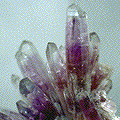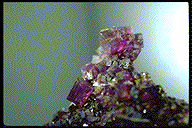Minerals by Name
A B C D E F G H I J K L M N O P Q R S T U V W X Y ZChoose a letter of the alphabet from the above list, and the minerals will be listed that begin with that letter.
This page also available in a frames version which simplifies mineral browsing.
Or see this list of ALL of our minerals
in alphabetic order on a single long page.
The Most Common Minerals
- QUARTZ is undoubtedly the single most common mineral in the Earth's crust, ranging from perhaps 12% of continental crust to as much as 50% of oceanic crust, as indicated by the composition of spreading-ridge volcanic lavas. Some estimates place quartz at 21% of the Earth's total lithosphere.
- FELDSPAR, (a group of related minerals) comprises the bulk of the Earth's crust, approximately 60% of the continental crust or 49% of the lithosphere. Perhaps 75% of this is the plagioclase feldspars (mostly albite, oligoclase and labradorite) with the remainder as potassium feldspars (mostly microcline and orthoclase).
- MICA (another group, primarily the minerals muscovite and biotite) comprises about 8% of the crust.
- OLIVINE (another group) is special. It's average composition mimics that of the bulk of the Earth - the mantle, which is nearly 1800 miles thick. Therefore, olivine is the most common mineral in the Earth, nearly 80% by volume, and that is a lot of peridot. It is the dense interior rock that the crust floats upon. Olivine is a major component of hot-spot volcanic lavas. About 15% of the crust is composed of olivines or their weathering/decomposition products, the PYROXENES (mostly augite) and the AMPHIBOLES (mostly hornblende).
- CALCITE comprises about 4% of the Earth's crust (but a lower percentage of the total lithosphere since it is unstable at the high temperatures of the inner mantle). It is important to note that the bulk of the Earth's carbon dioxide is tied up as calcite (calcium carbonate), otherwise the Earth's atmosphere might be 100 times as dense as at present and consist mostly of carbon dioxide, much like Venus (and with a similar impact on the planet).
- MAGNETITE is perhaps 3% of the crust.
- IRON, at least as the native element, is a nearly negligible component of the crust and the mantle, but the core of the earth is composed of a mixture of iron and nickel, and is, of course, mostly liquid. The inner core, approximately 1600 miles in diameter, is solid and thus qualifies as a mineral. The core composition, by weight, is approximately 85% iron, 5% nickel, and 10% lighter elements (mostly oxygen and sulfur).
Note that the Earth is strongly layered, with the densest components in the center (the core), and with lighter components above.
- Atmosphere: first 35km contains 99% of the atmosphere's mass, but each square inch column at the surface only weighs 15 pounds
- Hydrosphere: if spread evenly, water would comprise a 2.5km thick layer over the crust
- Crust: 5-70km thick layer of varying composition, mostly lighter silicates
- Upper Mantle: primarily olivine, averaging 625 km thick
- Lower Mantle: 2230 km thick, chemically also olivine, but with a denser, perovskite-like structure
- Outer Core: 2260 km of liquid iron/nickel
- Inner Core: 1210 km radius sphere of solid iron/nickel, which may be a single crystal - see Cohen & Stixrude










